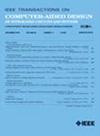基于car的模型检验中的假设排序重审
IF 2.9
3区 计算机科学
Q2 COMPUTER SCIENCE, HARDWARE & ARCHITECTURE
IEEE Transactions on Computer-Aided Design of Integrated Circuits and Systems
Pub Date : 2025-03-19
DOI:10.1109/TCAD.2025.3551658
引用次数: 0
摘要
模型检查是一种自动形式化验证技术,广泛应用于硬件验证。基于IC3/PDR及其通用变体CAR的最先进的完整模型检查技术,是基于对SAT求解器的多次调用来计算欠逼近和过逼近状态集(称为“帧”)的符号集。这些技术的性能对调用SAT求解器的假设顺序很敏感,因为如果公式不令人满意,求解器会发出不令人满意的核心,这对搜索过程产生了至关重要的影响。这一观察结果之前发表过(Dureja等人,2020),其中提出了两种偏假设排序策略,即交叉和旋转(偏假设的意思是它们只决定文字子集的顺序)。本文在分析这些策略有效原因的基础上,对其进行了扩展和完善。我们证明交集是有效的,因为我们称之为核心的局部性,我们改进的策略是基于这个观察。最后,我们对各种排序技术进行了广泛的实证评估。我们的策略之一,Hybrid-CAR,在运行时在策略之间切换,不仅优于其他固定排序策略,而且优于其他最先进的bug查找算法,如ABC-BMC。本文章由计算机程序翻译,如有差异,请以英文原文为准。
Revisiting Assumptions Ordering in CAR-Based Model Checking
Model checking is an automatic formal verification technique that is widely used in hardware verification. The state-of-the-art complete model-checking techniques, based on IC3/PDR and its general variant CAR, are based on computing symbolically sets of under- and over-approximating state sets (called “frames”) with multiple calls to a SAT solver. The performance of those techniques is sensitive to the order of the assumptions with which the SAT solver is invoked, because it affects the unsatisfiable cores that it emits if the formula is unsatisfiable—which the solver emits when the formula is unsatisfiable—that crucially affect the search process. This observation was previously published (Dureja et al., 2020), where two partial assumption ordering strategies, intersection and rotation were suggested (partial in the sense that they determine the order of only a subset of the literals). In this article we extend and improve these strategies based on an analysis of the reason for their effectiveness. We prove that intersection is effective because of what we call locality of the cores, and our improved strategy is based on this observation. We conclude our paper with an extensive empirical evaluation of the various ordering techniques. One of our strategies, Hybrid-CAR, which switches between strategies at runtime, not only outperforms other, fixed ordering strategies, but also outperforms other state-of-the-art bug-finding algorithms, such as ABC-BMC.
求助全文
通过发布文献求助,成功后即可免费获取论文全文。
去求助
来源期刊
CiteScore
5.60
自引率
13.80%
发文量
500
审稿时长
7 months
期刊介绍:
The purpose of this Transactions is to publish papers of interest to individuals in the area of computer-aided design of integrated circuits and systems composed of analog, digital, mixed-signal, optical, or microwave components. The aids include methods, models, algorithms, and man-machine interfaces for system-level, physical and logical design including: planning, synthesis, partitioning, modeling, simulation, layout, verification, testing, hardware-software co-design and documentation of integrated circuit and system designs of all complexities. Design tools and techniques for evaluating and designing integrated circuits and systems for metrics such as performance, power, reliability, testability, and security are a focus.

 求助内容:
求助内容: 应助结果提醒方式:
应助结果提醒方式:


